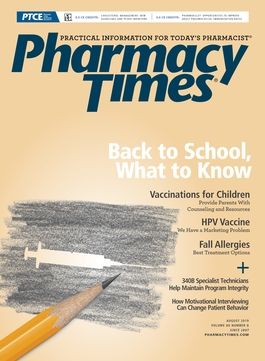Publication
Article
Pharmacy Times
Rocklatan From Aerie Pharmaceuticals, Inc
Author(s):
The FDA has approved Rocklatan (netarsudil and latanoprost ophthalmic solution) 0.02%/0.005%, from Aerie Pharmaceuticals, Inc, for the reduction of elevated intraocular pressure (IOP) in patients with ocular hypertension or open-angle glaucoma.
The FDA has approved Rocklatan (netarsudil and latanoprost ophthalmic solution) 0.02%/0.005%, from Aerie Pharmaceuticals, Inc, for the reduction of elevated intraocular pressure (IOP) in patients with ocular hypertension or open-angle glaucoma.1
Characterized by a progressive degeneration of retinal cells, glaucoma affects at least 60 million individuals worldwide. More than 2.7 million Americans are thought to be affected by glaucoma, but only about half are aware they have the condition. Although untreated glaucoma can lead to irreversible blindness and vision loss, appropriate treatment of the disease can prevent these adverse outcomes.2
PHARMACOLOGY AND PHARMACOKINETICS
Rocklatan is a fixed-dose combination of the Rho kinase inhibitor netarsudil and the prostaglandin F2α analogue latanoprost. Each component of the medication decreases IOP. Netarsudil restores outflow through the trabecular meshwork, whereas latanoprost increases fluid outflow through the uveoscleral pathway.1,2
DOSAGE AND ADMINISTRATION
The dose of Rocklatan is 1 drop in the affected eye or eyes once daily in the evening. If a dose is missed, the next dose should be administered the following evening. No more than 1 drop should be instilled per eye per day. Rocklatan may be used along with other topical ophthalmic medications to lower IOP, but the medications should be administered at least 5 minutes apart. Contact lenses should be removed before instilling Rocklatan and may be reinserted 15 minutes after the medication is administered.1
CLINICAL TRIALS
Rocklatan was evaluated in 2 phase 3 clinical trials of patients with ocular hypertension and open-angle glaucoma. The trials compared the IOP-lowering effect of Rocklatan with that of monotherapy of either once-daily netarsudil 0.02% or latanoprost 0.005%. In these studies, Rocklatan demonstrated a statistically superior IOP reduction compared with latanoprost or netarsudil. More than 60% of patients using Rocklatan in the 2 trials achieved an IOP reduction of 30% or more, which was nearly twice the frequency of the reduction achieved by the latanoprost group. Patients using Rocklatan also achieved low target pressures, with almost twice as many patients in the Rocklatan group reaching 16 mmHg or lower and nearly 3 times as many reaching 14 mmHg or lower compared with those taking latanoprost.1,2
CONTRAINDICATIONS, WARNINGS, AND PRECAUTIONS
There are no contraindications to treatment with Rocklatan.
Use of Rocklatan may lead to increased pigmentation of the eyelashes, the eyelid, and the iris. Although changes to the eyelashes and eyelid may be reversible once treatment is discontinued, changes to the iris are likely to be permanent. Eyelash changes, such as increased length, number, and thickness, may occur and are usually reversible after treatment is stopped. Macular edema, including cystoid macular edema, has been reported during use of latanoprost. Rocklatan should be used cautiously in patients with aphakic glaucoma, in pseudophakic patients with a torn posterior lens capsule, or those with known risk factors for macular edema. Because reactivation of herpes simplex keratitis has been reported during treatment with latanoprost, Rocklatan should be used cautiously in patients with a history of herpetic keratitis. Rocklatan should not be used in patients with active herpes simplex keratitis because it may exacerbate inflammation. Bacterial keratitis has been reported with the use of multiple-dose containers of topical ophthalmic products because of inadvertent contamination. Patients should be counseled to avoid contact of the dispensing container with the eye, fingers, surrounding structures, or other surfaces to minimize contamination.
Although no specific drug interaction studies with Rocklatan have been reported, in vitro studies have demonstrated that precipitation occurs when ophthalmic preparations containing thimerosal are mixed with latanoprost ophthalmic solutions. If ophthalmic medications containing thimerosal are used, they should be administered at least 5 minutes apart from Rocklatan. Additionally, concurrent use of 2 or more prostaglandins or prostaglandin analogues, including latanoprost, is not recommended, as administering multiple prostaglandin agents more than once daily may reduce the IOP-lowering effect or cause paradoxical elevations in IOP.
The most common adverse reaction is conjunctival hyperemia (59%). Other common adverse reactions include instillation site pain (20%), corneal verticillata (15%), and conjunctival hemorrhage (11%).1
Monitca Holmberg, PharmD, BCPS, earned her PharmD at the University of Connecticut in Storrs and completed an ambulatory care residency at the Phoenix VA Health Care System in Arizona. Her practice has also included pediatrics and inpatient mental health. She lives in Phoenix.
References
- Rocklatan [prescribing information]. Irvine, CA: Aerie Pharmaceuticals Inc; 2019. rocklatan.com/hcp/assets/pdf/Racklatan_Prescribing_Information.pdf. Accessed May 9, 2019.
- Aerie Pharmaceuticals announces U.S. FDA approval of Rocklatan (netarsudil and latanoprost ophthalmic solution) 0.02%/0.005% for the reduction of intraocular pressure in patients with open-angle glaucoma or ocular hypertension [news release]. Durham, NC: Aerie Pharmaceuticals Inc; March 12, 2019. investors.aeripharma.com/node/11516/pdf. Accessed May 9, 2019.







